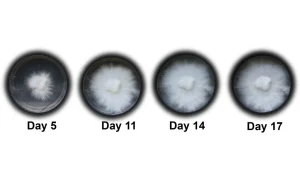Unremarkable in design but powered by a living king oyster mushroom, wheeled and soft-bodied robots move across the floor, CNN reports.
By growing the mushroom’s mycelium, or rootlike threads, into the robot’s hardware, a team led by Cornell University researchers has engineered two types of robots that sense and respond to the environment by harnessing electrical signals made by the fungus and its sensitivity to light.
The robots are the latest accomplishment of scientists in a field known as biohybrid robotics who seek to combine biological, living materials such as plant and animal cells or insects with synthetic components to make partly living and partly engineered entities.
Biohybrid robots have yet to venture beyond the lab, but researchers hope one day robot jellyfish may explore oceans, sperm-powered bots may be able to deliver fertility treatments and cyborg cockroaches could search for survivors in the wake of an earthquake.
“Mechanisms, including computing, understanding and action as a response, are done in the biological world and in the artificial world that humans have created, and biology most of the time is better at it than our artificial systems are,” said Robert Shepherd, a senior author of a study detailing the robots published August 28 in the journal Science Robotics.
“Biohybridization is an attempt to find components in the biological world that we can harness, understand, and control to help our artificial systems work better,” added Shepherd, a professor of mechanical and aerospace engineering at Cornell University who leads the institution’s Organic Robotics Lab.
Part fungus, part machine
The team began by growing king oyster mushrooms (Pleurotus eryngii) in the lab from a simple kit ordered online. The researchers chose this species of mushroom because it grows easily and quickly.
They cultivated the mushroom’s threadlike structures or mycelium, which can form networks that, according to the study, can sense, communicate and transport nutrients — functioning a little like neurons in a brain. (Alas, it’s not strictly accurate to call the creations shroom bots. The mushroom is the fruit of the fungi — the robots are powered by the rootlike mycelium.)

Mycelium produces small electrical signals and can be connected to electrodes.
Andrew Adamatzky, a professor of unconventional computing at the University of the West of England in Bristol who builds fungal computers, said it isn’t clear how fungi produce electrical signals.
The study team found it challenging to engineer a system that could detect and use the small electrical signals from the mycelia to command the robot.Mishra engineered an electrical interface that accurately reads the mycelia’s raw electrical activity, then processes and converts it into digital information that can activate the robot’s actuators or moving parts.
The robots were able to walk and roll as a response to the electrical spikes generated by the mycelia, and when Mishra and his colleagues stimulated the robots with ultraviolet light, they changed their gait and trajectory, showing that they were able to respond to their environment. The study noted that fungi can be cultivated in large quantities and can thrive in many different environments.
The researchers achieved a major breakthrough by operating the rolling robot without a tether, showcasing the potential for wireless fungal control. This development, according to researcher Webster-Wood, is particularly noteworthy.
Professor Shepherd envisions applications for fungi-controlled technology in agriculture, while Professor Adamatzky, a leading expert in fungal computing, outlines the vast potential of this field. Adamatzky’s lab has already produced over 30 sensing and computing devices using live fungi, including a self-healing robotic skin capable of responding to light and touch.









